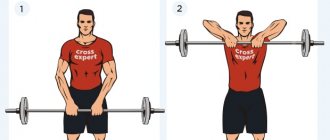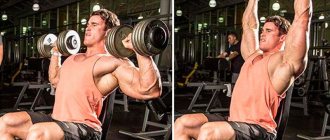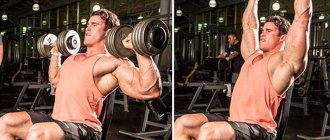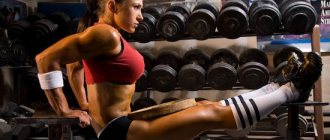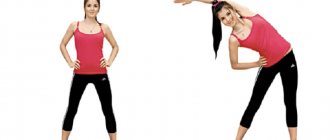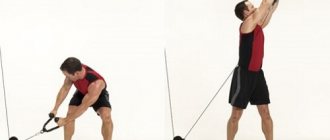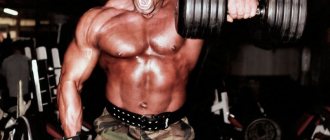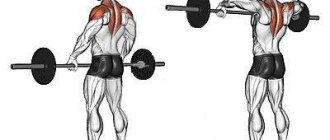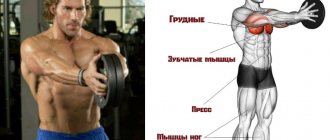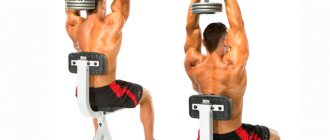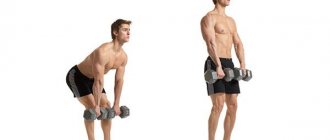Working muscles when raising dumbbells to the sides
Such exercises operate in an isolated format. Raising dumbbells to the sides, which muscles are involved: only the middle and lateral deltoids work. This is what obliges the athlete to be attentive to his health and select weight based on the degree of muscle readiness.
Attention! Under no circumstances should you lift heavy weights. The increase in load should be gradual.
There are several rules that will help protect muscles from injury.
Rules:
- if you plan to press standing or sitting on the day of shoulder training, then you should not attach the barbell to your chest;
- if the bench press is not expected, but there will be abduction and lifting, then on this day it is worth working out the triceps.
Muscles involved
During the exercise, different muscle groups are involved.
Basic
As already mentioned, two parts of the deltoid muscles - the middle and the back.
Additional
A considerable load falls on additional muscles :
- anterior bundle of deltoid muscle;
- trapezoid;
- serratus anterior;
- biceps.
Why Shoulders Are Often Injured?
The exercise itself is not that dangerous. What leads to injury is that the athlete performs the exercise thoughtlessly and puts a lot of aggression into the movements. Everyone wants the process of creating a beautiful shape to be quick, but it doesn’t happen. That is why swinging dumbbells to the sides while standing should be performed as calmly as possible.
There's a daily load on your shoulders. Just because you're sitting at work doesn't mean they're not stressed. And if you also carry heavy packages from the store home, then this is an additional load that negatively affects the shoulder girdle.
Most often, serious injuries are sustained by beginners who decide to start going to the gym after work. Without warming up, they begin to bench press and perform dumbbell swings to the side. They want beautiful shoulders, but they end up with sprains. The joints become overloaded and this leads to serious injuries.
For beginners, no more than 2-3 shoulder exercises are ideal.
The note! It is important to remember that such exercises should only be performed under the supervision of a trainer. There is no need to overestimate your capabilities.
You need to start the exercise with a minimum weight of 2-3 kilograms.
A shoulder injury is always a severe inflammation. It is never localized. The inflammatory process affects the entire muscle bundle. If injury occurs, you should not self-medicate. Go to the doctor, tell them what exercises you did, and treat your shoulders.
Bent over swings while sitting on a bench
For those who find it difficult to swing dumbbells to the sides while bending over in a standing position, an easier option was invented - sitting on a bench. It places your torso on your knees (literally).
The technique is like this:
- Find a bench, take small dumbbells.
- Sit on the edge facing the mirror. Bring your knees together.
- Lean forward with your back straight. Reach your chest to your knees and stop in this position.
- Your chest rests on your lap. In this pose, you reach 60–70 degrees of inclination relative to the plane of the floor.
- From this position, you will reach your hands to the floor. That is, the dumbbells are on the floor on either side of you.
- Take them and begin to lift them, trying to turn your elbows towards the ceiling. Without this, you will download something else.
- Do 3-4 sets of 10-12 reps. Don't forget to warm up well before the exercise. The rear deltoids can also be pulled. The muscle is small, but the force it creates is quite large.
Don’t forget to breathe correctly when doing dumbbell swings while sitting: when we raise our hands, we exhale, when we lower them, we inhale.
In this position, the knees press on the chest, making it difficult to breathe fully. Therefore, try not to lie completely on your knees.
Technique for performing dilutions
Before you start doing the exercises, you need to know what the exercise is aimed at. Swinging dumbbells through the sides is necessary in order to strengthen the lateral deltoids. If you do the exercise with errors, this will lead to the fact that the main emphasis will go to the front bundle.
Important!
Before you begin the exercise, warm up the muscles and joints of the shoulder girdle well. The longer you reheat, the better.
Dumbbell lateral raises – technique:
- Stand in front of the mirror. Take the minimum weight - no more than 4 kilograms.
- Straighten your back, straighten your shoulders. The legs must be placed at the width of the pelvic bones.
- Look straight into the mirror. The arms are slightly bent at the elbow joint. Throughout the entire exercise, the angle of flexion at the elbow should be static. We lower our arms to our sides. The brushes extend slightly forward beyond the border of the body.
- We take the dumbbells so that the palms look straight towards the body.
- We move our arms so that the elbows look back and up. The arms are raised until they are parallel to the floor.
- It is necessary to stay in the maximum lifting position for no more than 2 seconds.
At the beginning of any workout, remember that you need to start training with a minimum weight. This allows you to better warm up your muscles and avoid serious injury.
Important! No sudden movements or aggression. If you think that this will make you look more impressive, then remember that the desire to demonstrate masculinity will lead to injury, which means that the road to the gym will be closed for a long time.
Swings with one dumbbell
Dumbbell lateral raises while standing can be done even if only one dumbbell with the required weight is free in the gym. The exercises are performed with the same technique, but at the same time it is necessary to hold on to a support that will be static. This will avoid unnecessary vibration of the body, and therefore minimize the risk of possible injury.
In addition, this exercise will be of interest to those who are faced with muscle imbalance.
Important! No side bending. This can lead to pinched nerve endings.
Execution rules:
- The stance is exactly the same as when performing standard swings with two dumbbells.
- The weight for the arm is selected with the help of a trainer. If you are faced with muscle imbalance, do not be lazy to contact a specialist. This will help avoid injury and achieve a symmetrical result.
Dumbbell swings
Statement on personal data and confidentiality
Sportmenu greatly values the trust placed by its users and is aware of its responsibility to protect their privacy.
Specifically, we tell you what information we collect when you use the Services, why it is needed, and how it will be used to improve your user experience. Ensuring the confidentiality of user personal data in Sportmenu is based on the following principles:
- Use the information to create Services that take into account the needs and interests of users.
- Develop products to strict privacy standards.
- Ensure the transparency of collection necessary for order fulfillment purposes.
- Give users choices about how to protect their information.
- Manage the information received responsibly.
- Inform customers about special offers through email newsletters.
1.What information we collect and how we use it
We may require the following types of data:
- Information You Provide – When you register for an account with Sportmenu, we ask you to provide certain personal information. You can obtain additional information about your account in your Personal Account on Sportmenu. If you use your account when working with Sportmenu services, Sportmenu provides access to such services with the participation or on behalf of the domain administrator. In this case, the administrator has access to your account data.
- Cookies – When you visit Sportmenu, we send one or more cookies to your computer or other device. Cookies are used to improve the quality of services provided: to save user preferences, improve search results and the selection of products and advertising, and track user-specific trends, such as search patterns. Sportmenu also uses cookies in advertising services to help advertisers and publishers place advertisements and manage advertisements on sites across the Internet and within Sportmenu services.
- Browsing Information – When you access the Sportmenu Services through a browser, application or other client, our servers automatically record certain information. These server logs may contain information such as your web request, IP address, browser type and language, date and time of the request, and one or more cookies that can identify your browser or account.
- User Communications – When you send messages to Sportmenu (via email or other means), we may store those messages to process inquiries, answer questions and further improve our services. When you send or receive SMS, our text messaging-enabled services may collect and store the following information: phone number, carrier name, message content, date and time of transmission. Your email address may be used to contact you about our services.
- Sportmenu Services on Affiliated Sites – Some of the services we offer are linked to other sites. Personal information you provide to such sites may be transferred to Sportmenu to provide these services. We process this type of information in accordance with this privacy policy.
- Third Party Applications – Through the Sportmenu Services, third party applications, such as gadgets or extensions, may be made available to users. The information you provide when you turn on a gadget or launch a third-party application is processed by Sportmenu in accordance with this privacy policy. The gadget or application developer treats the information it collects in accordance with its own privacy policy.
- Other Sites – This privacy policy applies only to the Sportmenu Services. We do not control the sites that use Sportmenu applications, products and services or that are linked to from our Services. These sites may place their own cookies on your computer, collect data, or solicit personal information from you.
In addition, the information we collect may be used for the following purposes:
- Supply, support, secure and improve our Services (including advertising services), as well as develop new services and Services.
- Protecting the rights and property of Sportmenu and our users.
Before we use information for purposes other than those stated at the time it was collected, we will ask your permission for such use.
In accordance with Federal Law dated July 27, 2006 N 152-FZ “On Personal Data,” by accepting the terms of this Regulation, you give your consent to Sportmenu to process and transfer your personal data for the purpose of providing Sportmenu Services to you, as well as placing your orders. Personal data permitted for processing under this Consent is provided by you by filling out the registration form on the Sportmenu website, and includes the following information: Last name, First name. Middle name, age, phone number, address, email address (e-mail). The processing of your personal data can be carried out without a time limit, in any legal way, including in personal data information systems using automation tools or without the use of such tools.
You agree that Sportmen has the right to transfer my personal data to third parties, in particular, owners of online stores registered on the website, as well as courier services solely for the purpose of fulfilling your orders placed on Sportmenu, including for delivery purposes goods.
2.Choices
To view and manage information stored in your Sportmenu account, you can use the Sportmenu Personal Account.
Most browsers are initially set to accept cookies, but you can reset these settings and have the browser block all cookies or notify you when cookies are being sent. Please note that some Sportmenu features and services may not function properly if you disable cookies.
3.Providing access to information
Sportmenu provides access to personal information to other companies and individuals unaffiliated with Sportmenu only under the following limited circumstances:
- We have your permission to do this. We require your explicit consent to transmit any confidential information.
- We provide this type of information to our subsidiaries, affiliates, and other trusted organizations and individuals only for the purpose of processing personal information on our behalf and to fulfill your order. When processing such information, we require that these third parties follow our instructions and comply with this privacy policy and take other steps necessary to protect your privacy.
- We have a reasonable belief that access, use, preservation or disclosure of such information is necessary to (a) comply with any applicable law, regulation, legal process or valid governmental request, (b) comply with the applicable Service Agreement, including investigation potential violations, (c) detect and prevent fraudulent activity, and address security and technical problems, or (d) protect against imminent threat of harm to the rights, property or safety of Sportmenu, its users or the public, as required or permitted by law.
If Sportmenu becomes involved in a merger, acquisition, or any other form of sale of some or all of its assets, we will maintain the confidentiality of any personal information involved in the transaction and will notify you before personal information is transferred and becomes subject to a different policy privacy.
4.Information protection
We take all necessary measures to protect data from unauthorized access, modification, disclosure or destruction. These measures include, but are not limited to, internal review of data collection, storage and processing processes and security measures, including appropriate encryption and physical data security measures to prevent unauthorized access to the systems on which we store personal data.
We restrict access to personal information to those employees, contractors and partners of Sportmenu who need to have that information to carry out the transactions carried out to fulfill your order. These individuals are required to comply with confidentiality obligations and may be subject to penalties, including termination and criminal prosecution, if they violate these obligations.
5.Access to and update of personal information
When you use the Sportmenu Services, we will do our best to provide you with access to your personal data and either correct it if it is incorrect or delete it at your request, unless retention is required by law or for legitimate business purposes. Before processing requests, we ask users to confirm their identity and the information they want to access, correct, or delete. We may refuse to comply with requests if they are repeated or too frequently, if the technical implementation of the requests requires excessive effort on our part, if they jeopardize the privacy of other users, if fulfilling the requests is impractical (for example, the requested information is stored on tape media for backup), and also if access to information does not require a special request. Whenever we provide access to information and the ability to correct it, we do so free of charge unless doing so would require a disproportionate amount of effort on our part. Due to the nature of some services, once information is deleted from active servers, it may remain for a limited period of time in our backup systems until it is permanently deleted.
6.Compliance
Sportmenu adheres to the principles of privacy adopted in the Russian Federation, as set out in the legislative acts of the Russian Federation, regarding notice, choice, transfer, security, data integrity, data access and enforcement.
Sportmenu regularly reviews compliance with this privacy policy. Upon receipt of a formal complaint in writing, Sportmenu is committed to contacting the complaining user regarding their complaints or concerns. We will cooperate with the relevant data protection regulators to resolve any transfer of personal data that cannot be resolved between Sportmenu and an individual.
7.Changes to this privacy policy
Please note that this privacy policy may change from time to time. We do not intend to limit the scope of your rights under this privacy policy without your express permission. We will publish changes to the privacy policy on this page. If the changes are significant, we will notify you in a more explicit manner.
Lateral raises of dumbbells - basic mistakes
It's not just newbies who make mistakes. Professionals can also make mistakes. But, not from ignorance, but because for a split second they lost control. Unfortunately, this happens.
Standard errors:
- The desire to gain relief as quickly as possible. This leads to the athlete taking on weight that is too heavy for himself. As a result, the exercise is not performed correctly. This leads to severe injury to the muscles of the shoulder girdle.
- Extra movements. Sometimes beginners reflexively make unnecessary movements: they roll from heel to toe or change the position of their legs. You can’t do this, it can also lead to injury. The body must be static.
- Incorrect trajectory of performing dumbbell lateral raises while standing. Throwing a projectile towards the head is a direct path to injury and inflammation of the ligaments.
- Error in setting the home position. Sometimes beginners are faced with such a problem as positioning the body, namely the back, with a tilt back. Under no circumstances should you do this! This is dangerous not only for the muscles of the shoulder girdle, but also for the spine. For this reason, we urge beginners to contact professional trainers who will help you set up the exercise technique correctly.
- Uneven lifting of dumbbells on the left and right. This happens if the spine is curved. In this situation, we recommend consulting a doctor, wearing a special corset, and performing the exercise with only one arm at a time.
- Incorrect pelvic position. Beginners also suffer from this: they slightly bend the hip joint. This results in the load being distributed incorrectly.
- Hip flexion due to fatigue. If you feel too tired, it is better to stop doing the exercise altogether rather than putting weight on the hip joint, thereby making the task easier for yourself.
- Involvement of other muscles in work. This also happens because the athlete is tired. Tired? Rest. To practice reflex muscle isolation, contact a trainer. This will help you get a better feel for the area you are working on.
As you can see, there are a lot of errors. To hone a technique to perfection, you need patience and desire. It is important to be aware that any incorrect movement can lead to injury!
Errors
These points of error can make the exercise ineffective and harm your health:
- Small tilt angle. In this position, the middle bundle of deltas works. If you want to pump it up, you need to do other exercises, for example, standing dumbbell flyes.
- The elbows are turned back - in this position the necessary part of the shoulder is not loaded again. Elbows should look straight up, at the ceiling, at the sky. Keep an eye on this.
- Arms straight - other back muscles are involved in the work, although you were only going to pump the back of the shoulder. Why do you need this?
- When the weight is heavy, the arms bend during the exercise. The angle at the elbow joint should be fixed at all times. If you feel that you cannot perform a single repetition (or few) without curling your arms, take a lighter weight.
- For beginners, it is difficult to tense the desired muscle; they do not know (because they have not yet felt) what should work in a particular exercise and what should not. Therefore, they swing in an inclined position in such a way that they strain their entire back. The correct technique and awareness of how to work will come later along with training experience.
- Round back. You are in a slanted position. If you round your back, the load will fall on your lower back, which may not end very well. The correct position for this exercise is a bend in the lower back.
Features of the exercise
Raising arms with dumbbells while standing to the sides is an exercise that has its own characteristics. Taking these features into account and following the rules will help you achieve the necessary relief while maintaining healthy joints.
Peculiarities:
- Wiring is performed only with the weight that is right for you. How do you know what weight you need? Go to the trainer. There is no need to select the weight at random. Most beginners start working with this exercise with 2-3 kilograms.
- If you take too little weight, nothing will change. If you take too much weight, the load will most likely transfer to the elbow joint. In this situation, the execution technique suffers greatly. Too much weight will result in injury.
- If you raise your arms too high, the trapezius muscles will be involved in the work. Did you have plans to train this muscle group? Fine. If not, then make sure that your arms with dumbbells are raised parallel to the floor.
- You need to raise your arms while exhaling. We return to the starting position while inhaling.
- When performing the last repetition, hold your arms parallel to the floor for 10-15 seconds. This will help strengthen your muscles. and consolidate the effect of the training.
- You need to lower your arms smoothly, without sudden movements or aggressive throws.
To perform the exercise correctly, knowledge and skill are required. At first, contact your coach for help. This way you will learn more nuances about performing the exercise and protect your ligaments and joints from injury. In addition, remember that good results cannot be achieved if you do not monitor your diet.
5/5 — (24 votes)
Share link:
Shoulder anatomy
We already talked about the anatomy of the shoulders in an article about how to pump up the deltoid muscles.
So, the deltoid muscles, as we know, are divided into three parts:
- Front.
- Middle (lateral).
- Rear.
Each part (each bundle) performs its functions:
- Front delta – raises the lowered arm up, bends the shoulder, while simultaneously turning it inward.
- Rear delta – lowers the raised arm down, straightens the shoulder, while simultaneously turning it outward.
- Lateral (middle) delta – moves the arm to the side. When the entire muscle contracts, it abducts the arm approximately 65-75 degrees.
In general, at the link above you can read all the more complete information and nuances of the anatomy of your deltas.
